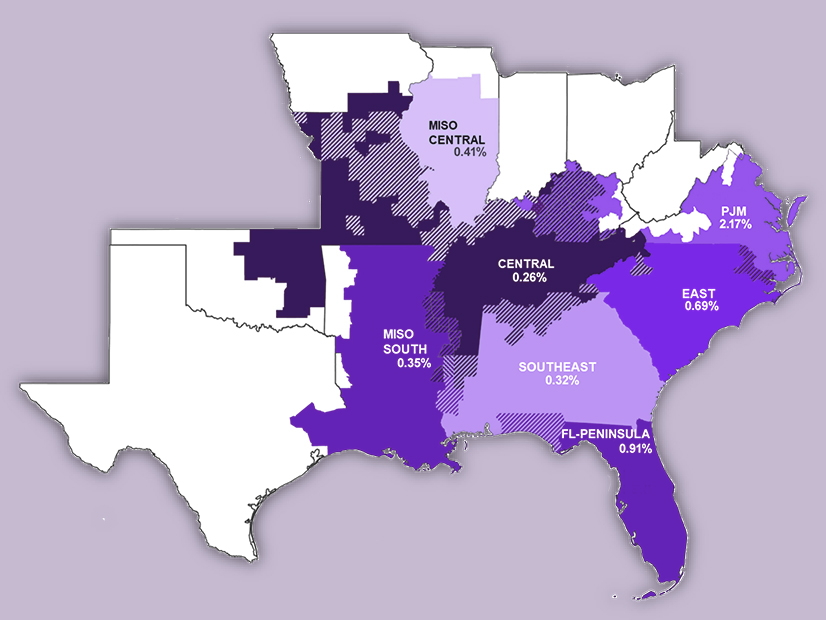SERC Reliability sounded a note of confidence in its Long-Term Reliability Assessment (LTRA), released this month, predicting that planning reserve margins in most of its subregions will be more than enough to meet demand over the next 10 years.
However, the regional entity also noted the ongoing changes to the electric grid’s generation mix and growing stresses from extreme weather, and warned that system operators must be prepared for rapidly changing circumstances to maintain reliability.
DER Growth to Offset Demand
The LTRA is based on data collected from registered entities in SERC’s seven subregions and is intended to identify “trends, emerging issues, and potential risks” over the 2022-2031 assessment period. Some of the data was also provided to NERC for the ERO-wide LTRA last year, in which SERC was one of the few regions where none of the footprint was assessed as facing high or elevated risk of energy shortfalls. (See NERC Warns of Ongoing Extreme Weather Risks.) SERC said some of the data in the new report “reflects further updates … since the release of the NERC report.”
SERC’s report projected “almost flat” demand across the territory until 2031, with nearly all its subregions expecting average annual load growth of less than 1%. The outlier is SERC PJM, which includes all or parts of North Carolina, Virginia and Kentucky, where load is projected to grow 2.17% annually from 2022-2031.
However, the RE specified that it does expect electricity demand to grow despite slow expansion in net load thanks to factors like electrification of transportation and the anticipated switch to electric residential heating — which will also help turn some subregions from summer- to winter-peaking.
SERC said the demand growth will likely be offset by adoption of rooftop solar panels and other distributed energy resources (DER) that “mask the residential load on the system” — a phenomenon that experts have been warning about for years. (See Rooftop PV’s ‘Hidden Loads’ Challenge Grid Planners.)
The RE noted DERs as a particular issue in the SERC East subregion, comprising South Carolina and most of North Carolina, and SERC Central, which includes all or parts of Alabama, Georgia, Iowa, Kentucky, Mississippi, Missouri, North Carolina, Oklahoma, Tennessee and Virginia. In both subregions SERC said entities must work to adjust their system models to account for the role of DERs in absorbing residential demand.
All subregions except the MISO-Central area — which includes all or parts of Iowa, Kentucky, Missouri and Illinois — expect to have enough resources to meet their prospective reserve margins through 2031. In MISO-Central, a summer-peaking area, entities are projected to fall short of the 15% summer reference reserve margin in every year through 2031 because of planned generation retirements, mostly among coal plants. However, SERC observed that the subregion “has access to additional firm deliverable resources up to the MISO regional directional transfer limit.”
More Work Needed on IBRs
The region’s ongoing move from thermal resources to renewables garnered a separate section in the report, with SERC noting that “many states and utilities … have established, or have proposals to establish, carbon reduction goals and promote the integration of greater levels of renewable resources such as solar, wind and battery energy storage.”
Because of these resources’ variable energy output, they rely on inverters to connect to the grid. As with DERs, this creates difficulties in modeling because these inverter-based resources (IBR) do not behave the same way as traditional resources. Like NERC and other REs, SERC expects this problem to grow in importance as the penetration of IBRs on the grid continues.
“Even as industry experience grows, and as effective modeling and engineering study techniques are developed into guidelines and reliability standards to meet these challenges, IBR commissioning practices for utilities remain an area of challenge and are still to be addressed,” the report said.
It highlighted two documents produced by SERC’s Variable Energy Resource Working Group — the SERC Guidance Document for IBR Commissioning Process and the SERC Guidance Document for IBR Interconnection Practices — as valuable resources for registered entities to update their practices. Both documents are available upon request through the SERC website.




